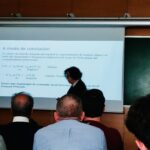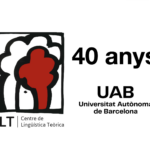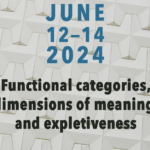4 setembre, 2023
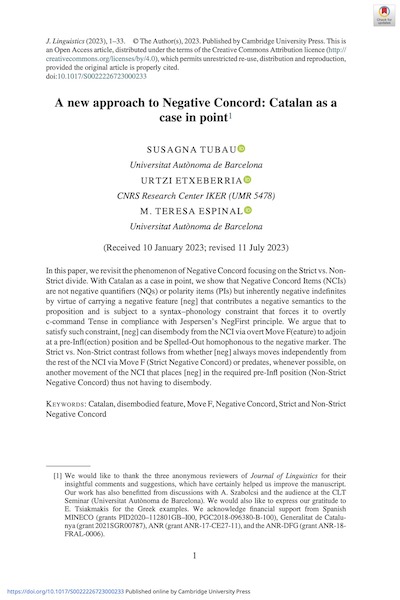
Autors:
Susagna Tubau, Urtzi Etxeberria i M.Teresa Espinal
Títol:
A new approach to Negative Concord: Catalan as a case in pointEditorial: Journal of Linguistics (Cambridge University Press)
Data de publicació: Juliol del 2023
Pàgines: 33 Més informacióIn this paper, we revisit the phenomenon of Negative Concord focusing on the Strict vs. Non-Strict divide. With Catalan as a case in point, we show that Negative Concord Items (NCIs) are not negative quantifiers (NQs) or polarity items (PIs) but inherently negative indefinites by virtue of carrying a negative feature [neg] that contributes a negative semantics to the proposition and is subject to a syntax–phonology constraint that forces it to overtly c-command Tense in compliance with Jespersen’s NegFirst principle. We argue that to satisfy such constraint, [neg] can disembody from the NCI via overt Move F(eature) to adjoin at a pre-Infl(ection) position and be Spelled-Out homophonous to the negative marker. The Strict vs. Non-Strict contrast follows from whether [neg] always moves independently from the rest of the NCI via Move F (Strict Negative Concord) or predates, whenever possible, on another movement of the NCI that places [neg] in the required pre-Infl position (Non-Strict Negative Concord) thus not having to disembody.
6 juny, 2023
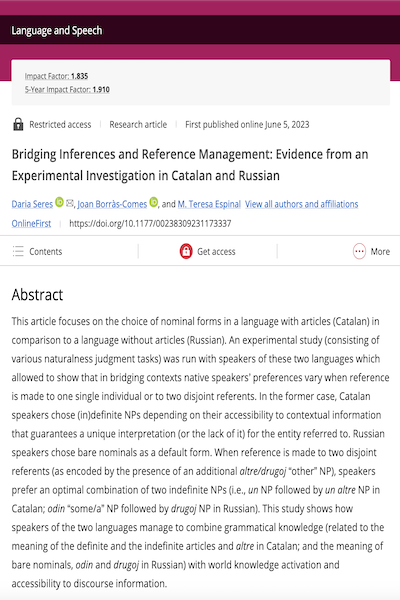
Autors:
Dària Serés, Joan Borràs-Comes & M.Teresa Espinal
Títol:
Bridging Inferences and Reference Management: Evidence from an Experimental Investigation in Catalan and RussianEditorial: Language and Speech (Sage Journals)
Data de publicació: 5 juny, 2023
Més informacióThis article focuses on the choice of nominal forms in a language with articles (Catalan) in comparison to a language without articles (Russian). An experimental study (consisting of various naturalness judgment tasks) was run with speakers of these two languages which allowed to show that in bridging contexts native speakers’ preferences vary when reference is made to one single individual or to two disjoint referents. In the former case, Catalan speakers chose (in)definite NPs depending on their accessibility to contextual information that guarantees a unique interpretation (or the lack of it) for the entity referred to. Russian speakers chose bare nominals as a default form. When reference is made to two disjoint referents (as encoded by the presence of an additional altre/drugoj “other” NP), speakers prefer an optimal combination of two indefinite NPs (i.e., un NP followed by un altre NP in Catalan; odin “some/a” NP followed by drugoj NP in Russian). This study shows how speakers of the two languages manage to combine grammatical knowledge (related to the meaning of the definite and the indefinite articles and altre in Catalan; and the meaning of bare nominals, odin and drugoj in Russian) with world knowledge activation and accessibility to discourse information.
27 febrer, 2023
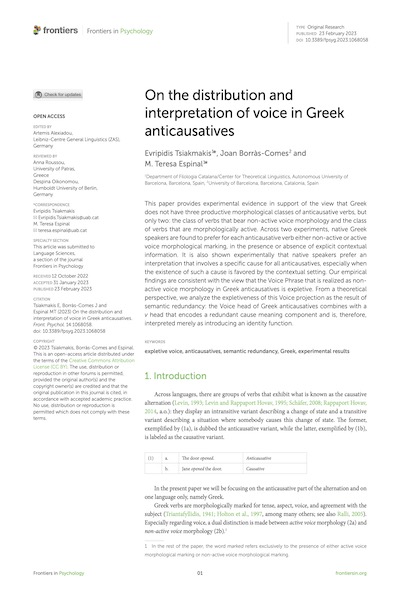
Autors:
Evripidis Tsiakmakis, Joan Borràs-Comes i M.Teresa Espinal
Títol:
On the distribution and interpretation of voice in Greek anticausatives. Frontiers in PsychologyEditorial: Frontiers
Data de publicació: 23 de febrer del 2023
Pàgines: 15 Text completThis paper provides experimental evidence in support of the view that Greek does not have three productive morphological classes of anticausative verbs, but only two: the class of verbs that bear non-active voice morphology and the class of verbs that are morphologically active. Across two experiments, native Greek speakers are found to prefer for each anticausative verb either non-active or active voice morphological marking, in the presence or absence of explicit contextual information. It is also shown experimentally that native speakers prefer an interpretation that involves a specific cause for all anticausatives, especially when the existence of such a cause is favored by the contextual setting. Our empirical findings are consistent with the view that the Voice Phrase that is realized as non-active voice morphology in Greek anticausatives is expletive. From a theoretical perspective, we analyze the expletiveness of this Voice projection as the result of semantic redundancy: the Voice head of Greek anticausatives combines with a v head that encodes a redundant cause meaning component and is, therefore, interpreted merely as introducing an identity function.
29 desembre, 2022
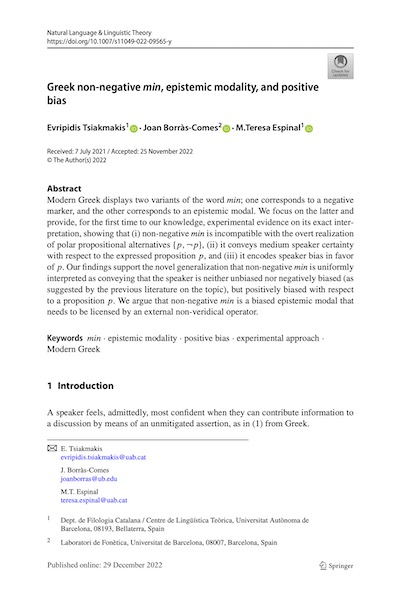
Autors:
Evripidis Tsiakmakis, Joan Borràs-Comes & M.Teresa Espinal
Títol:
Greek non-negative min, epistemic modality, and positive biasEditorial: Natural Language & Linguistic Theory (Springer)
Data de publicació: 29 de desembre del 2022
Text completModern Greek displays two variants of the word min; one corresponds to a negative marker, and the other corresponds to an epistemic modal. We focus on the latter and provide, for the first time to our knowledge, experimental evidence on its exact interpretation, showing that (i) non-negative min is incompatible with the overt realization of polar propositional alternatives {p,¬p}, (ii) it conveys medium speaker certainty with respect to the expressed proposition p, and (iii) it encodes speaker bias in favor of p. Our findings support the novel generalization that non-negative min is uniformly interpreted as conveying that the speaker is neither unbiased nor negatively biased (as suggested by the previous literature on the topic), but positively biased with respect to a proposition p. We argue that non-negative min is a biased epistemic modal that needs to be licensed by an external non-veridical operator.
15 agost, 2022
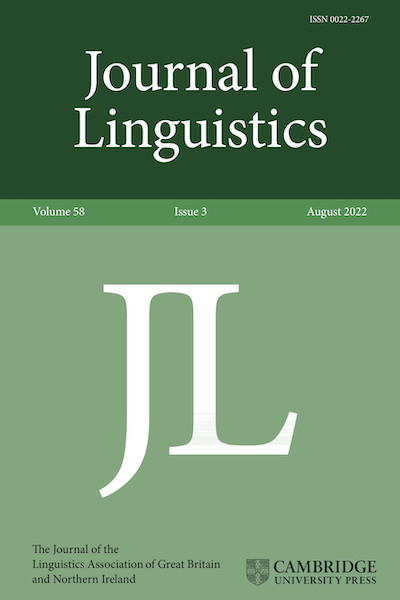
Autors:
M.T. Espinal & Sonia Cyrino
Títol:
A syntactically-driven approach to indefiniteness, specificity and anti-specificityEditorial: Journal of Linguistics 58(3), Cambridge University Press
Data de publicació: Agost 2022
Més informacióIn this paper we present an original approach to analyze the compositionality of indefinite expressions in Romance by investigating the relevance of their syntactic distribution in relation to their meaning. This approach has the advantage of allowing us to explore the question of how syntactic structure can determine the meaning of different forms of indefiniteness. To that end, we postulate a common derivation for bare plurals, bare mass and de phrases, whereby an abstract operator DE is adjoined to definite determiners and shifts entities into property-type expressions. Quantificational specificity is proposed to be derived from a syntactic structure in which weak quantifiers select for indefinite DE-phrases, no matter whether de is overt at Spell-Out or not; these quantifiers turn properties into generalized quantifiers. The anti-specificity meaning of some indefinites is derived by adjoining in the syntactic structure an abstract operator ALG that encodes the speaker’s epistemic state of ignorance to a quantifier encoded for specificity, and it turns a generalized quantifier into a modified generalized quantifier. The paper also brings some general predictions on how indefiniteness is expressed in Romance, as it provides extensive support from five Romance languages: Brazilian Portuguese, Catalan, French, Italian and Spanish.







